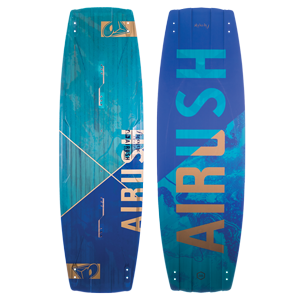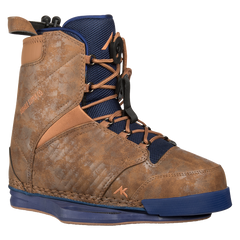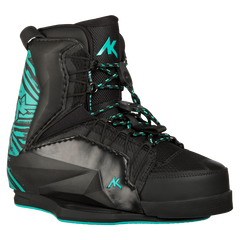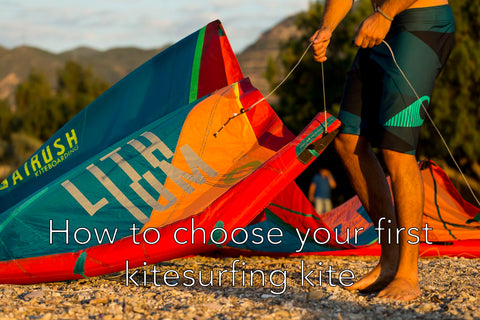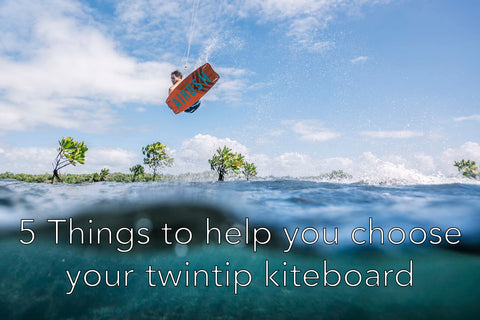
Kiteboarding With Boots - All You Need To Know Guide

Probably many of you already seen that kitesurfing with boots is getting more and more popular amongst kiters. As we are closely involved with Airush kite boot development and we’ve been riding kiteboarding bindings for a few years already, we thought we could give you some useful advice.
Alex was one of the first riders that introduced wakeboarding boots in PKRA world tour being the first person to ever win an international and World Tour event using boots and infected the kiteboarding world and especially freestyle riders with this crazy idea when most pro riders were riding straps.
If you want to transition from straps to more unhooked/wakestyle oriented riding, then putting kite boots on your kiteboard would be the obvious progression. Without further ado, let’s start:
When I’m ready to kite with boots?
We get this question a lot of the time. You have to know that riding boots has a lot of benefits but also has its own dangers, so definitely you need to have a really good level and kite control to make sure you’re safe when riding boots. It’s hard to tell the exact moment to switch your straps for boots but basically you have to tick the following boxes:
- You have really good kite control so you can use both of your hands to tighten up your laces when you’re at the beach without letting the kite crash.
- You should ideally do most of your tricks unhooked, as we don’t highly recommend them if your main focus is hooked in tricks and high jumps. The reason we don’t is because when you crash on boots, your board will get stuck on the water, so you should let go of your bar to avoid the catapult effect, when being hooked in, it’s hard to let go of you bar and crashes would be more painful, but if you’re unhooked and you let go of your bar when you crash, the impact shouldn’t be a problem.
Choosing right size for your kite bindings
If you have a chance always try them out first, go to your local wake or kitesurf shop and try few different pairs and see what fits for you.
Try to get the bindings as tight as possible, so that your toes just touch the end of the boot, but they don’t curl up, otherwise it will be painful to ride and it will be a hassle to exchange if they are already used. Most of the kite boots are made with memory foam or similar material, they will mold to your feet after few sessions, so you might need to endure the first few uncomfortable sessions.
If you don’t have a chance to try them out, check the manufacturers recommended sizing guide and call the kite shop to speak with the experts.
What kiteboard would you recommend for boots?
We recommend to ride boards that have more rocker, as they are more suited for wakestyle riding. Kiteboards that have higher rocker (curvature of the board) offer more explosive pop, helps with high speed landings, because the rocker is slowing down the board, and you can go in more overpowered conditions.
Another consideration would be to check if the board has reinforced inserts, as it’s a common place where it breaks when kiting with boots.
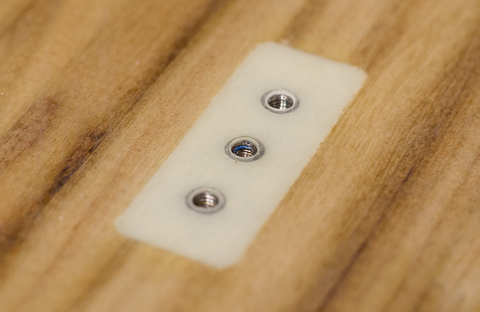
Airush ABS Reinforced Inserts
Try to avoid riding boots with beginner boards that are flat and flexible, because they will spray so much water to your face and it’s not going to be fun. But also it will neutralise your pop because of the board flex. Also when the kiteboard is flexible It’s quite easy to dive the front of the board while landing a trick and making a faceplant.
Kiteboarding boots or wakeboarding bindings? What’s the difference?
Kiteboarding boots are an evolution from the wakeboarding bindings. At the beginning all the kiteboarders that started riding bindings were using wakeboarding ones but we found that we break them very easily, so some kite brands started to focus on developing kiteboarding specific boots. As an example AK Team boots or AK Reefer boots from AK Durable Supply Co. (Airush Kiteboarding) are specifically made for kiteboarding focusing on comfort and durability at the same time.
The main differences we can find is that when we kitesurf, we have to go upwind and wakeboarders don’t, so we need a bigger range of torsion in our boots as our position is quite a bit less vertical than wakeboarders, so if you’re riding wake boots they might suffer more on the middle area.
Another main difference between kite and wake is that we (kiters) are always attached to the kite, whether we are hooked in or unhooked whilst wakeboarders are more used to let go the handle, so the base plate in our boots tend to suffer more when we are kiting and therefore bend with time, so kite specific boots will generally have a more rigid base plate to prevent this from happening.
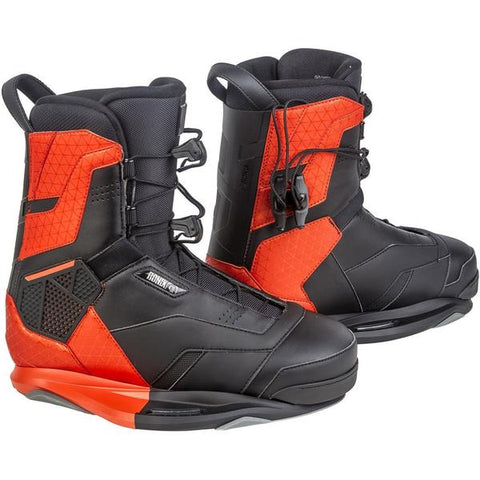
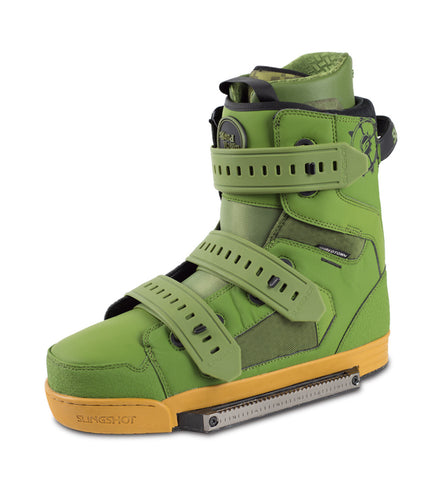
In general, Wakeboarding boots for kitesurfing can be a good option to go for, as there are more wakeboarding companies such Ronix, Liquid Force, Jobe, Humanoid and etc. Therefore there is a bigger range of wake bindings to choose from and for different budgets. Just be careful if you decide to go for wake boots as if they’re not too reinforced they might break very easy.
Choosing your stance
Before choosing your stance, we need to talk about how the knees absorb the impact during a landing and how to avoid knee injuries while kitesurfing.
We have two cartilage pads in the knees that are called lateral and medial meniscus. They cushion and stabilise the knee joint and protect the bones from wear and tear. So if the impact is distributed equally for both pads it helps to cushion the blow. And if the impact is unbalanced then one of the side will take more of the impact, which increases the risk of damage to that side of the meniscus.

To prevent this you need to choose a stance width that is well balanced and shares the load of the impact on both sides of the knee joint equally.
A good starting point is to stand slightly wider than your shoulder width, which for the average male rider is about 48-50 cms and female about 44-46 cms from one inner screw to the other in your kiteboard. But this is just a reference point, you have to test it for yourself to see what feels the most comfortable, because each person have a different knee anatomy.
Also what we need to take in consideration is what difference having a wider or narrower stance is gonna make in our riding.
When we choose a narrow stance we are able to spin faster when we are in the air, we can go higher when we take off from a wave or a kicker as our ollie jumps are easier, and also we are on a more natural position so we should be more comfortable on the water, especially when it’s choppy. The main disadvantage of a narrow stance is that it will make our life harder when it comes to difficult landings as we have a smaller base we can lose balance easier.
If you want to go for big tricks and not much rotation, that’s when you rather have a wider stance, like we said before, a wider stance will make your landings a lot easier but for sure it will be harder to spin.
Choosing your angle
Now that you know your most comfortable stance, you want to simulate a landing (making a squat with your feet positioned on your right stance) to determine on which angle you are gonna set up your boots. It’s quite simple, your feet have to be in line with your knees when you get down to that 90 degree angle.
A lot of people tend to bend their back and keep their knees straight when they land a trick, and that’s not good if you want to protect your body. The right way to land is making a squat and keeping our back as straight as possible.
An important thing to mention is when you make a squat, try to find a position where you get the least stress on your hips, ankles, knees and back. If you feel stress or you’re out of balance, you might want to re adjust your stance.
Alex setup is 50cm stance (middle inserts on Airush Livewire board) and 34 degrees (24 degrees on outside and 10 degrees inside).
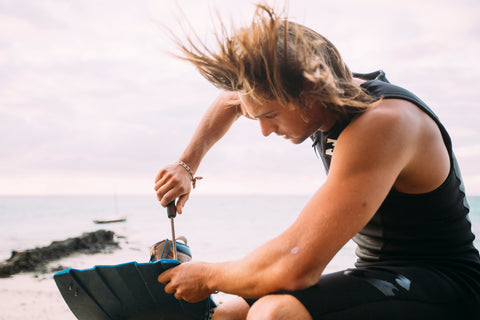
Kiteboarding boots vs straps? Which one?
If you’re doing hooked in tricks and want to do big air then you would consider staying with straps. If you love to ride more wakestyle and/or do unhooked tricks then kiteboard boots is the way to go. Now we dive in why you should choose one or the other option:
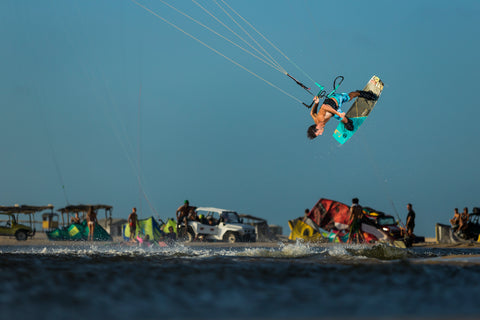
Advantages for kite boots:
- Bigger pop - you can hold an edge way harder with boots and therefore pop harder, this would help you to do bigger and higher unhooked tricks.
- Stability & control - Land harder, hold more power with more control over the kiteboard.
- Protect your ankles and knees - If you get your boots tight, your ankles should be rock solid so it would be very hard to twist them. Your knees will also bend straighter than using straps so you have less chances of injuring them.
Disadvantages for kite boots:
- Harder to go upwind
- Harder crashes - One of the main disadvantage of riding boots is the crashes, if you have done any wakeboarding you probably know the scorpion (catching an edge) can be painful, but if you get used to let go of the bar as you crash, you could avoid that massive crash.
- Needs more power than usual - Because kite boots can add extra weight and you need to ride a board with more rocker, you might need one or two more knots to get going.
- More expensive than straps - prices range from 130€ up to 400€ and more for a new pair of boots.
- Takes some time to get in and out.
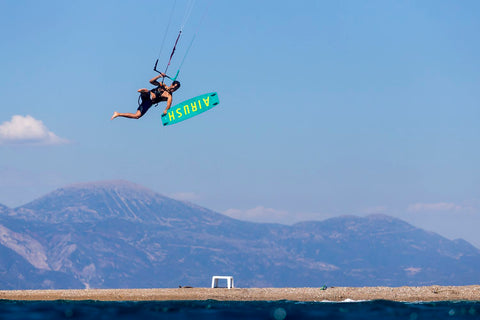
Advantages for kitesurf straps:
- Easy to go in and out of the straps - if there is not enough wind to go upwind then you can quickly jump out of the straps and walk back
- Softer crashes - can abandon the board mid air
- Cheaper
- More flexible
Disadvantages for kitesurf straps:
- Possibly the foot slipping out of the strap and making a split
- Less control & stability - cannot land as hard.
- Risk of twisting your ankles.
How to put the bindings on:

Step 1. Make sure your boots are unlaced and as loose as possible, it will be easier to get your feet in.
Step 2. Get both feet in.
Step 3. Sit down, it’s way easier to tighten the kite boots when you’re sitting. First make sure that you have the kite steady in one position, as you will need to let go off the bar at certain times. You can even put the kite on the ground if you’re struggling keeping the kite up, but we don’t really recommend it.
Riding tips with boots
If you decided to change from straps to boots that’s awesome! But there’s some things you need to take into consideration.
First, you should learn that when you crash with boots, your kiteboard is not gonna get out of your feet (if you tighten your boots properly, which you should) but your kite will still pull, so you must let go of your bar to avoid the catapult effect, which is something you didn’t have with straps, as you automatically lose the board on a big crash.
Now we are aware catching an edge is our worst enemy, you will have that in your mind and you will learn to let go of the bar every time you crash. This could help you improve your style and rotate with more momentum and bring your legs in front of you before passing the bar on tricks like backmobes, fbm, etc.
Try to do your tricks now with your kite a bit lower and you can ride faster into the pop, riding boots will help you with that.
Recovering from crashes
The easy way:

Step 1. Choose which way you want to jump to and let go of your back hand to help you balance your body.
Step 2. Start bringing your kite and depower up so you can move comfortably and the kite won’t be pulling you.
Step 3. Twists your legs (clockwise on this case) while you push back with your hand so your board ends up downwind from you.
Step 4. Keep turning yourself with the help of your backhand and prepare for waterstart.
Step 5. Get back and try again the trick you missed.
The harder way:

Step 1. Choose a side where you want to go and have the kite on the opposite side. If going to the right then have your kite at 11 o’clock.
Step 2. Get your legs behind you and send your kite towards 1 o’clock.
Step 3. Pull the bar in around 12.30, like you’re doing a jump.
Step 4. Put your legs in front, so that you don’t catch an edge.
Step 5. Ride like a boss.
Check out AK & Airush kite boots in our shop
Liked our kiteboarding with boots guide?
Why not check the other kitesurfing guides
Comments
Hi Guido, normally if you don’t get your feet wet, then it shouldn’t stick to your feet, unless the sand is already wet then it’s a little bit trickier, Otherwise try to stand on the middle of the board and wipe your feet. Other way you could go next to the water and dip your feet in and wash the sand off. Hope that helps, regards from Tarifa!
Hi…is there any way to not get sand in your boots on the beach before you put them on…thanks
i wish they would have explained the situation in the “recovering from crashes” section when the kite is in the water on its LE in front of you, pulling u constantly downwind, lets say in 20-25knts & up
Great review and infos, thank you!!




